The Valley of Kings, a majestic resting place for ancient pharaohs, embodies the profound beliefs of the Egyptian civilization regarding life after death. Its intricate tombs, filled with vivid hieroglyphs, tell stories of power and legacy, while the nearby Temple of Hatshepsut impresses with its architectural grandeur and symbolism of female strength. Both sites offer a glimpse into the remarkable engineering prowess of ancient Egypt, raising questions about the lives of those interred within. What secrets lie hidden in these ancient walls, waiting to be uncovered?
Good To Know
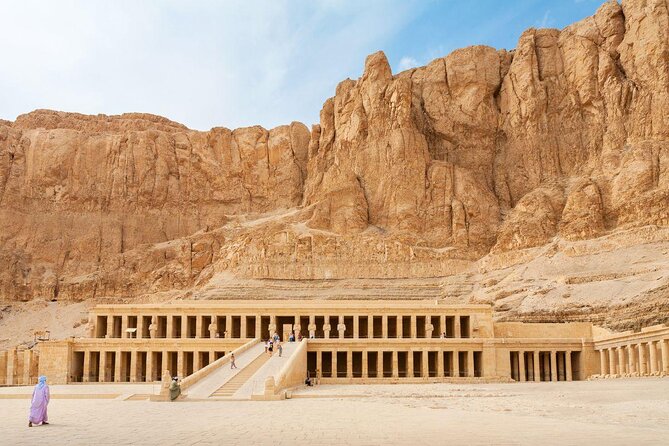
- The Valley of Kings served as a sacred burial ground for powerful pharaohs, established between the 16th and 11th centuries BCE.
- Hatshepsut’s Temple, with its multi-level design and grand terraces, symbolizes her power and is set against stunning limestone cliffs.
- The Valley of Kings features key tombs like Tutankhamun, Ramses II, and Seti I, showcasing elaborate burial practices and artistry.
- Ancient Egyptian art, including hieroglyphics in tombs, reflects the civilization’s beliefs in immortality and their connection to the divine.
- Private guided tours to the Valley of Kings and Hatshepsut’s Temple enhance the experience with expert insights and comfortable transportation.
Historical Significance of the Valley
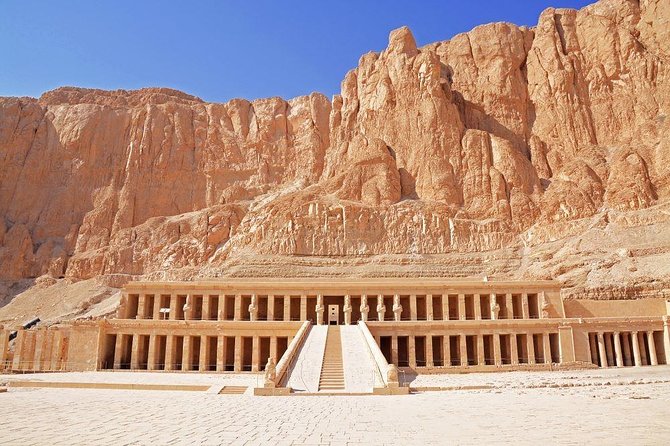
Nestled between the towering cliffs of the Theban mountains, the Valley of Kings serves as a sacred burial ground, housing the tombs of Egypt’s most powerful pharaohs and showcasing the civilization’s profound reverence for the afterlife.
Established during the 16th to 11th centuries BCE, this site reflects the ancient Egyptians’ beliefs in immortality and divine kingship.
Each tomb, intricately designed and adorned with vivid hieroglyphs, tells the story of its inhabitant, from their life achievements to their journey into the afterlife.
The valley not only served as a final resting place but also as a symbol of the pharaohs’ eternal connection to the gods.
Today, it stands as a UNESCO World Heritage site, preserving a crucial chapter of human history.
Find more activities and experiences we've covered in Luxor.
Discovering Hatshepsut’s Temple
Hatshepsut’s Temple, an architectural marvel of ancient Egypt, captivates visitors with its grand terraces and striking colonnades, reflecting the pharaoh’s unique role as one of the few female rulers in a predominantly male-dominated society. Nestled against the cliffs of Deir el-Bahari, this temple showcases a harmonious blend of nature and human ingenuity. The intricate reliefs and statues narrate Hatshepsut’s extraordinary reign, making it a significant historical site.
| Feature | Description | Significance |
|---|---|---|
| Architecture | Multi-level design with terraces | Symbolizes Hatshepsut’s power |
| Reliefs | Detailed carvings depicting her life | Offers insight into her legacy |
| Location | Set against limestone cliffs | Enhances its grandeur |
| Colonnades | Rows of columns supporting the structure | Reflects ancient engineering skills |
| Access | Easily reachable for visitors | Promotes tourism and education |
Key Tombs in the Valley
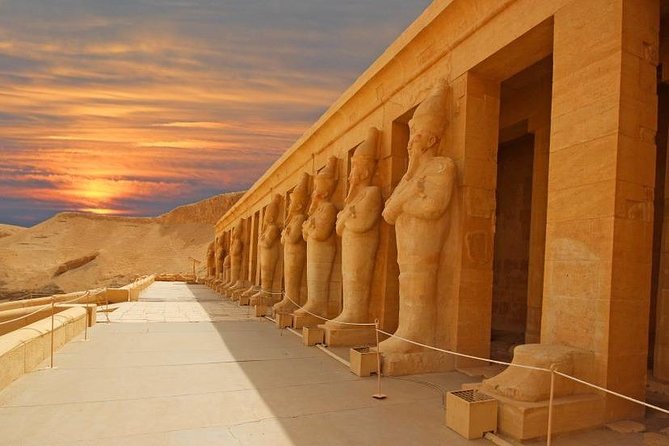
The Valley of Kings, located just a short distance from the grandeur of Hatshepsut’s Temple, is home to some of ancient Egypt’s most significant tombs, each revealing the rich history and elaborate burial practices of the pharaohs.
Among these, the tomb of Tutankhamun stands out, famous for its remarkable treasures, including the iconic golden mask.
Another notable site is the tomb of Ramses II, showcasing stunning wall reliefs that depict his military exploits.
The tomb of Seti I features intricate carvings and extensive hieroglyphs that provide invaluable insights into ancient Egyptian beliefs.
These key tombs not only reflect the artistry of their time but also serve as a testament to the pharaohs’ quest for immortality in the afterlife.
Importance of Ancient Egyptian Art
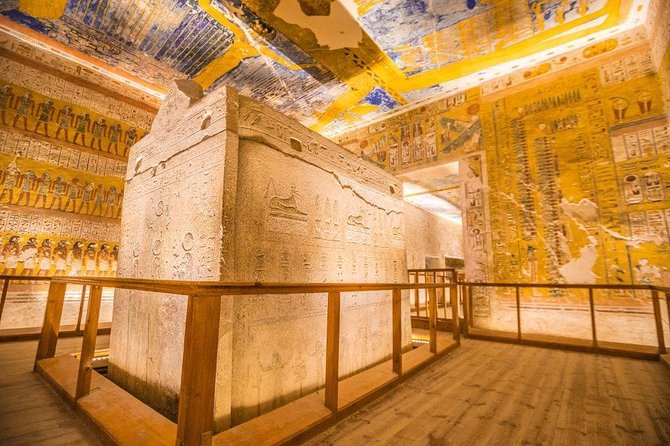
Ancient Egyptian art serves as a vital window into the civilization’s beliefs, values, and daily life, showcasing the intricate craftsmanship and symbolic significance that permeated their culture.
Each piece, from monumental sculptures to intricate jewelry, reflects a society deeply connected to the divine and the afterlife. Artists employed specific colors and forms, conveying messages that transcended time.
Hieroglyphics adorned tomb walls, narrating spiritual journeys and honoring deities. Plus, art played a crucial role in rituals, reinforcing community bonds and societal structure.
The meticulous attention to detail demonstrated not just skill but a profound respect for the subjects portrayed.
Ultimately, ancient Egyptian art remains a powerful testament to a civilization that sought to immortalize its essence through beauty and meaning.
Guided Tour Experience
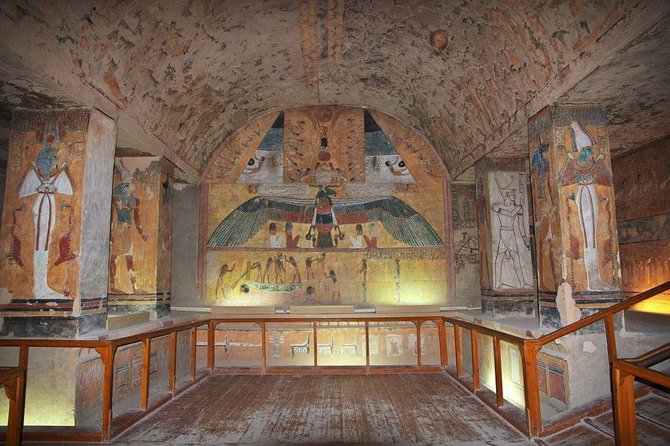
Exploring the Valley of Kings and the awe-inspiring temple of Hatshepsut through a guided tour offers a unique opportunity to connect with the rich history and artistry that defined ancient Egypt. Travelers enjoy a personalized experience, led by knowledgeable Egyptologists who bring ancient stories to life.
| Feature | Description |
|---|---|
| Private Tour | Only your group participates |
| Transfers | Air-conditioned vehicle provided |
| Bottled Water | Complimentary during the tour |
| Entrance Fees | Included for all mentioned sites |
| English-Speaking Guide | Expert guidance throughout the journey |
This engaging tour enhances understanding of ancient rituals, architecture, and the significance of these historic sites, making it a unforgettable experience for history enthusiasts.
Accessibility Features for Visitors
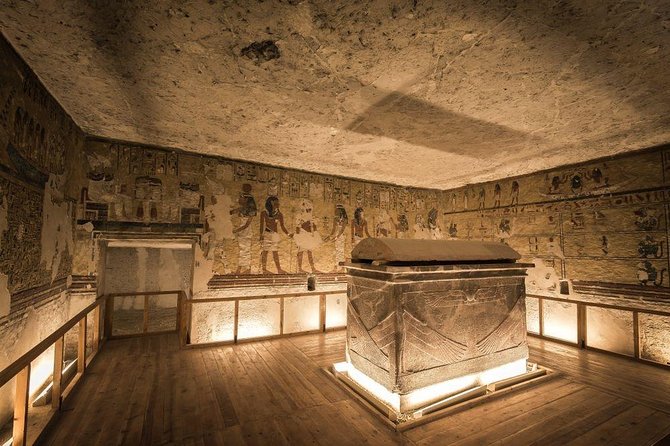
Visitors will find that the tour is thoughtfully designed to accommodate various accessibility needs, ensuring everyone can enjoy the remarkable sites of the Valley of Kings and Hatshepsut.
With a commitment to inclusivity, the tour offers:
Wheelchair-accessible surfaces throughout the sites
Stroller-friendly pathways for families with young children
Private transportation in an air-conditioned, accessible vehicle
Availability of infant seats and permission for service animals
These features enable all guests to explore the ancient wonders comfortably.
Whether navigating the impressive temples or engaging with knowledgeable guides, visitors experience both ease and enjoyment.
This dedication to accessibility ensures a memorable adventure for everyone, making history’s treasures available to all who wish to discover them.
Planning Your Visit
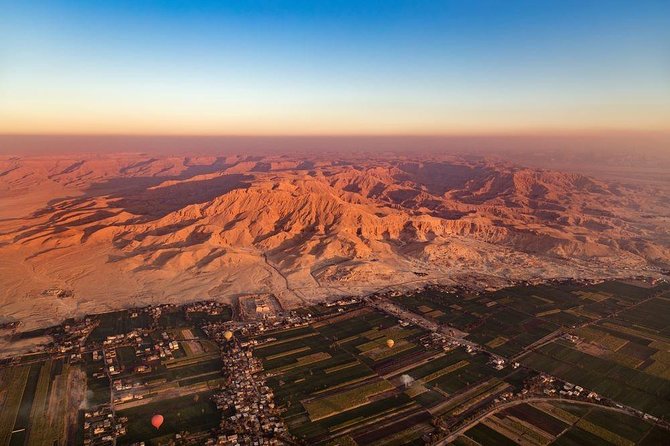
To make the most of a trip to the Valley of Kings and Hatshepsut, careful planning is key to ensuring a smooth and enriching experience.
Visitors should consider starting their day early, as the operating hours run from 7:00 AM to 12:00 PM, allowing ample time to explore the magnificent tombs and temples.
It’s advisable to confirm pickup details from hotels in Luxor at least 24 hours in advance.
A private air-conditioned vehicle enhances comfort, while a knowledgeable English-speaking Egyptologist guide provides invaluable insights into the rich history.
Travelers should also ensure they’ve bottled water to stay hydrated in the Egyptian sun.
With thoughtful preparation, one can fully appreciate the allure of this ancient site.
Booking and Cancellation Information
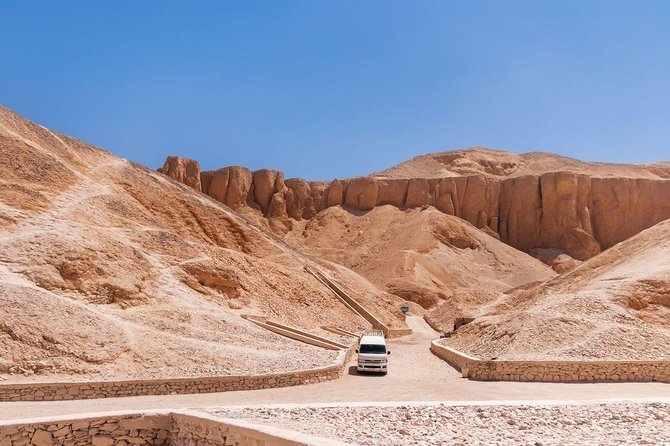
Booking a tour to the Valley of Kings and Hatshepsut offers travelers the peace of mind that comes with a lowest price guarantee and the flexibility of free cancellation up to 24 hours before the experience starts. This makes it easy for anyone to plan their unforgettable journey.
Key features of the booking process include:
Easy online reservation with instant confirmation
Private tours tailored to your group’s preferences
Flexible payment options—reserve now, pay later
Dedicated English-speaking Egyptologist guide for an enriched experience
With these benefits, travelers can explore the wonders of ancient Egypt without worry, ensuring a memorable adventure in Luxor.
Enjoy the beauty and history while knowing that plans can be adjusted if necessary.
Frequently Asked Questions
How Long Does the Entire Tour Typically Last?
The entire tour typically lasts around five hours. Participants enjoy a comprehensive experience, exploring various sites, guided by an expert Egyptologist, while comfortably traveling in a private air-conditioned vehicle, ensuring a memorable adventure.
Are There Any Age Restrictions for Children on the Tour?
There aren’t any specific age restrictions for children on the tour. Families can enjoy the experience together, as the tour accommodates various ages, including infants and those needing special assistance, ensuring everyone has a memorable time.
Can We Take Photos Inside the Tombs and Temple?
Visitors can’t take photos inside the tombs and temples, as it’s prohibited to preserve the ancient art and artifacts. However, outside areas offer stunning photo opportunities, capturing the beauty of Luxor’s historical sites.
Is Food Provided During the Tour, or Should We Bring Our Own?
The tour doesn’t include food, so they recommend bringing snacks or a light meal. Travelers can enjoy refreshments during the journey, ensuring everyone stays energized while exploring the breathtaking sites of Luxor.
What Should We Wear for Comfort While Exploring?
For comfort while exploring, he recommends lightweight, breathable clothing, sturdy walking shoes, and a wide-brimmed hat. Sunblock’s essential, too, as the sun can be intense during daytime excursions in warm climates.
The Sum Up
The Valley of Kings and Hatshepsut’s Temple offer a captivating glimpse into ancient Egyptian civilization, revealing the profound beliefs in immortality and the remarkable achievements of its rulers.
Visitors can enjoy the intricate artistry and monumental architecture that define this UNESCO World Heritage site.
As they explore the rich history and stunning landscapes, they’ll leave with a deeper appreciation for Egypt’s enduring legacy and the powerful stories etched in stone by its pharaohs.
More Tour Reviews in Luxor
Looking for something different? Other Luxor activities we've written about
- Full-day East and West Bank tour with lunch from Luxor
- Valley of the Queens and King Tuts Tombs Hatshepsut in Luxor
- Private Half Day Tour West Bank of the Nile Luxor Egypt
- 18 Best Shopping Tours In Luxor
- 5 Best Workshops And Classes In Luxor
- 21 Best Sailing Experiences In Luxor
- 20 Best Historical Tours In Luxor
- 20 Best 3 Day Tours In Luxor
- 16 Best Snorkeling Experiences In Luxor
- 25 Best Boat Tours And Cruises In Luxor
- 20 Best 4 Day Tours In Luxor
- 20 Best Private Driver Services In Luxor
